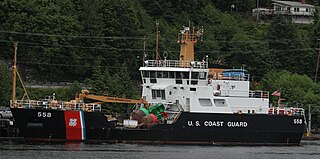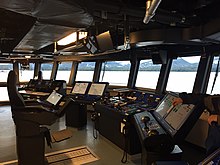
The Iñupiat are a group of Indigenous Alaskans whose traditional territory roughly spans northeast from Norton Sound on the Bering Sea to the northernmost part of the Canada–United States border. Their current communities include 34 villages across Iñupiat Nunaat, including seven Alaskan villages in the North Slope Borough, affiliated with the Arctic Slope Regional Corporation; eleven villages in Northwest Arctic Borough; and sixteen villages affiliated with the Bering Straits Regional Corporation. They often claim to be the first people of the Kauwerak.

The University of Alaska System is a system of public universities in the U.S. state of Alaska. It was created in 1917 and comprises three separately accredited universities on 19 campuses. The system serves nearly 30,000 full- and part-time students and offers 400 unique degree programs.

The University of Alaska Fairbanks is a public land-grant research university in College, Alaska, a suburb of Fairbanks. It is the flagship campus of the University of Alaska system. UAF was established in 1917 and opened for classes in 1922. Originally named the Alaska Agricultural College and School of Mines, it became the University of Alaska in 1935. Fairbanks-based programs became the University of Alaska Fairbanks in 1975.
The University of Alaska Southeast is a public university with its main campus in Juneau, Alaska and extended campuses in Sitka and Ketchikan. It is part of the University of Alaska System and was established on July 1, 1987, with the restructuring and consolidation of the former University of Alaska Juneau, Ketchikan Community College, and Islands Community College (Sitka). The university is accredited by the Northwest Commission on Colleges and Universities.

Iñupiaq or Inupiaq, also known as Iñupiat, Inupiat, Iñupiatun or Alaskan Inuit, is an Inuit language, or perhaps group of languages, spoken by the Iñupiat people in northern and northwestern Alaska, as well as a small adjacent part of the Northwest Territories of Canada. The Iñupiat language is a member of the Inuit-Yupik-Unangan language family, and is closely related and, to varying degrees, mutually intelligible with other Inuit languages of Canada and Greenland. There are roughly 2,000 speakers. Iñupiaq is considered to be a threatened language, with most speakers at or above the age of 40. Iñupiaq is an official language of the State of Alaska, along with several other indigenous languages.

RV Knorr was a research vessel formerly owned by the U.S. Navy and operated by the Woods Hole Oceanographic Institution for the U.S. research community in coordination with and as a part of the University-National Oceanographic Laboratory System (UNOLS) fleet. On March 14, 2016, Knorr was officially transferred to the Mexican Navy and renamed Rio Tecolutla. She was replaced at Woods Hole by the RV Neil Armstrong. Knorr is best known as the ship that supported researchers as they discovered the wreck of the RMS Titanic in 1985. R/V Knorr (AGOR-15) has traveled more than a million miles—the rough equivalent of two round trips to the Moon or forty trips around the Earth. Her sister ship is the RV Melville.

M/V Prince of Wales is a ferry operated by the Inter-Island Ferry Authority. She serves as a replacement for her sister ship, M/V Stikine, when she is out of service for maintenance. Her route is from Ketchikan to Hollis in Southeast Alaska.
Susan Henrichs became provost of the University of Alaska Fairbanks (UAF) in July 2007, after serving as dean of the Graduate School and vice provost of UAF from 2003 to 2007.
Nicholas Farrar Hughes was a British and American fisheries biologist known as an expert in stream salmonid ecology. Hughes was the son of the American poet Sylvia Plath and English poet Ted Hughes, and the younger brother of artist and poet Frieda Hughes. He and his sister were public figures as small children due to the circumstances of their mother's widely publicized suicide.

USCGC Sycamore (WLB-209) is a United States Coast Guard seagoing buoy tender, the second of her name and the ninth of the Juniper-class. She is now home-ported in Newport, Rhode Island, following a one year long Midlife Maintenance Availability (MMA) in Baltimore, Maryland. She was originally home-ported in Cordova, Alaska. Sycamore primarily tends to aids-to-navigation (ATON) in Martha's Vineyard, the Long Island Sound, Hudson River, and New York City Harbor and entrances; however she is also responsible for maintenance support of National Data Buoy Center's offshore weather buoys. In addition to her primary ATON role, Sycamore also performs other duties, such as, marine environmental protection, maritime law enforcement, domestic icebreaking, search and rescue, and homeland security missions.

The Arctic policy of the United States is the foreign policy of the United States in regard to the Arctic region. In addition, the United States' domestic policy toward Alaska is part of its Arctic policy.

The College of Fisheries and Ocean Sciences, or CFOS, is part of the University of Alaska Fairbanks. CFOS offers a bachelor of arts and a bachelor of science in fisheries, master’s and doctoral degrees in oceanography, fisheries and marine biology, and a minor in marine science.

USS Raeo (SP-588) was a United States Navy patrol vessel in commission from 1917 to 1919. Prior to her U.S. Navy service, she operated as the motor passenger vessel Raeo from 1908 to 1917. After the conclusion of her U.S. Navy career, she served as the fishery patrol vessel USFS Kittiwake in the United States Bureau of Fisheries fleet from 1919 to 1940 and as US FWS Kittiwake in the Fish and Wildlife Service fleet from 1940 to 1942 and from 1944 to at least 1945, and perhaps as late as 1948. During World War II, she again served in the U.S. Navy, this time as the yard patrol boat USS YP-199. She was the civilian fishing vessel Raeo from 1948 to 1957, then operated in various roles as Harbor Queen from 1957 to 1997. She became Entiat Princess in 1998 and as of 2009 was still in service.

NOAAS Reuben Lasker is a National Oceanic and Atmospheric Administration (NOAA) fishery research vessel. The ship's namesake, Reuben Lasker, was a fisheries biologist who served with the Southwest Fisheries Center, National Marine Fisheries Service, and taught at the Scripps Institution of Oceanography.

NOAAS David Starr Jordan (R444)) was an American fisheries research vessel in commission in the National Oceanic and Atmospheric Administration (NOAA) from 1970 to 2010. She previously was in the United States Fish and Wildlife Service's Bureau of Commercial Fisheries fleet from 1966 to 1970 as US FWS David Starr Jordan.

Erin Christine Pettit is an American glaciologist focusing on climate change. She is an associate professor of geophysics and glaciology at Oregon State University. Her work focuses on ice-ocean interactions, ice-shelf disintegration, sea-level rise and ocean circulation changes.
Edna Ahgeak MacLean a.k.a. Paniattaaq is an Iñupiaq academic administrator, linguist, anthropologist and educator from Alaska, who has specialized in the preservation and revitalization of the Iñupiaq language.

MV Brown Bear was an American research vessel in commission in the fleet of the United States Department of Agriculture′s Bureau of Biological Survey and Alaska Game Commission from 1934 to 1940 and in the fleet of the United States Department of the Interior′s Fish and Wildlife Service from 1940 to 1942 and from 1946 to 1951, under the control of the University of Washington from 1952 to 1965, and in commission in the fleet of the United States Fish and Wildlife Service from 1965 to 1970 and of the National Oceanic and Atmospheric Administration′s National Marine Fisheries Service (NMFS) from 1970 to 1972.

USFS Brant was an American fishery patrol vessel that operated in the waters of the Territory of Alaska and off Washington, California, and Mexico. She was part of the United States Bureau of Fisheries (BOF) fleet from 1926 to 1940. She then served as US FWS Brant in the fleet of the Fish and Wildlife Service from 1940 to 1953. She then operated commercially until she sank in 1960.

USCGC Anthony Petit (WLM-558) is a Keeper-class coastal buoy tender of the United States Coast Guard. Launched in 1999, she has served her entire career maintaining navigational aids in Southeast Alaska. She is assigned to the Seventeenth Coast Guard District.


















